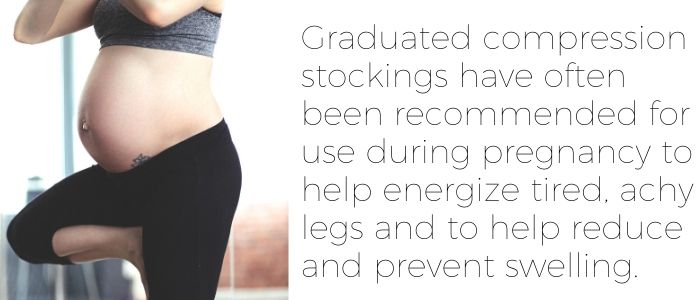
Preggers by Therafirm have been making compression hosiery for over 50 years.
What is Gradient Compression?
Compression has long been used to help prevent swelling and combat tired, achy feet and legs. True gradient compression helps improve blood flow. The garments are tightest at the ankle and the tightness gradually decreases up the leg. This naturally helps the body promote better circulation.
What does Gradient Compression do?
Graduated compression stockings have often been recommended for use during pregnancy to help energize tired, achy legs and to help reduce and prevent swelling. True gradient compression hosiery is designed to provide a controlled amount of pressure greatest at the ankle and gradually decreases towards the top of the stocking. This naturally helps the body promote better circulation.
What does mmHG mean?
mmHg stands for millimeters of Mercury and is the measurement is used to measure pressure. Since gradient compression hosiery exert a gradually decreasing amount of pressure up the leg, this unit of measure helps express the amount of pressure the wearer will feel.
Common compression levels (amount of pressure or tightness the garment places on the leg) include light (10-15 mmHg), mild (15-20 mmHg), moderate (20-30 mmHg), and firm (30-40 mmHg). The compression level for the Preggers maternity range is 10-15 mmHg and we have just introduced the mild level to our range, 15-20 mmHg.

Support vs Compression vs Gradient Compression
The terms support, compression and gradient or graduated compression are often used interchangeably. However, they are not the same!
Support pantyhose is another way to say control top or shaping support. They do not provide any compression or support in the legs or feet.
Compression products are tight all over. The garment normally provides the same amount of pressure throughout.
Gradient compression is tightest at the ankle and the pressure gradually decreases up the garment. This helps to promote circulation, energize tired, achy legs, and help prevent and reduce swelling.

Tips for Donning Maternity Compression Hosiery
For many women that have never worn compression hosiery before, putting on your new stockings can be difficult. Generally it will take about 10-15 minutes to put on - longer for greater compression levels. Compression hosiery has more resistance or compression than traditional pantyhose hose or stockings. Because they fit more snug, they are a little more difficult to put on. Wearing light cotton gloves (these are usually provided by your doctor when they recommend compression leg wear) will prevent fingernails or jewellery catching on the delicate fabric.
- Insert hand & grab stocking at top of heel pocket.
- While still holding heel pocket, turn top of stocking down towards toe.
- Open stocking & slide foot in until toe & heel are positioned in place.
- Knee-highs: Grasp top of stocking and pull up over ankle and calf. Position tops approximately 1" below bend of knee.
- Pantyhose & Tights: With crotch in a snug, comfortable position, stretch panty hose with both hands. Adjust waist band to preferred position either folded under the belly or pulled up and over the belly.

Once the garment is on check for the following:
- The foot portion must fit the shape of the foot. The stockings should have even compression or elasticity so that the sock takes on the anatomical shape of the foot without high compression (binding points) that may create discomfort or circulation obstruction. Observe the bare foot prior to donning once side. After putting on the stocking, the foot shape should be consistent with that of the bare foot.
- For footless garments, the bottom of garment should be placed at the ankle bone or the skinniest part of the ankle.
- If pain, discomfort, or areas of binding occur, the stockings should be removed.
Note. the same garment is not designed to be worn everyday - these are foundation garments and should have proper wear rotation to ensure longevity
Note, you should consult with your doctor before wearing compression stockings.
SHOP THE COMPRESSION RANGE HERE >
FAQ
Q What is the difference between the Preggers leggings and footless tights?
A The leggings are a more opaque and thicker hosiery fabric, so better to wear in cooler weather or if you want a darker, matte legging. The footless tights are great for summer.
Q Can I wear the leggings on their own?
A The fit is very tight being compression wear, you will be able to see your pantyline so we suggest wearing the entire range with tunics or under dresses.
Q Can I return them for a refund?
A Due to hygiene reasons, compression hosiery cannot be returned or exchanged if they have been tried on. Any returns must be in their original packaging and box.
Q Can I wear them under pants for work?
A Yes you can although we recommend only wearing in an air-conditioned environment as you will feel warmer with both layers on.
Q Can I wear them on the airplane?
A Yes they are designed to help blood circulation and help prevent deep vein thrombosis. Please always consult with your doctor before wearing compression wear.
Q Can I wear the same product everyday?
A The same garment is not designed to be worn everyday - these are foundation garments and should have proper wear rotation to ensure longevity. Just like your regular hosiery we advise having 2-3 pairs if wearing daily.
